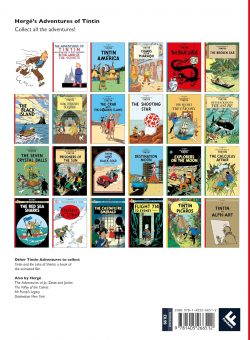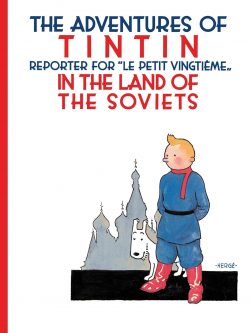

By Hergé translated by Leslie Lonsdale-Cooper & Michael Turner (Farshore)
ISBN: 978-1-40521-477-3 (HB)
Georges Prosper Remi, known all over the world as Hergé, created a true masterpiece of graphic literature with his tales of a plucky boy reporter and entourage of iconic associates. Singly, and later with assistants including Edgar P. Jacobs, Bob de Moor and the Hergé Studio, Remi completed 23 splendid volumes (originally produced in brief instalments for a variety of periodicals) which have grown beyond their popular culture roots and attained the status of High Art.
Like Dickens with the Mystery of Edwin Drood, Hergé died while working, so final outing Tintin and Alph-Art remains a volume without an official conclusion, but still a fascinating examination – and a pictorial memorial of how the artist worked. It’s only fair though, to ascribe a substantial proportion of credit to the many translators whose diligent contributions have enabled the series to be understood and beloved in 70 languages. The subtle, canny, witty and slyly funny English versions are the work of Leslie Lonsdale-Cooper & Michael Turner.
On leaving school in 1925, Remi worked for Catholic newspaper Le XXe Siècle where he apparently fell under the influence of its Svengali-like editor Abbot Norbert Wallez. The following year, the young artist (himself a dedicated boy scout) produced his first strip series – The Adventures of Totor – for monthly Boy Scouts of Belgium magazine. By 1928 he was in charge of producing the contents of Le XXe Siècle’s children’s weekly supplement Le Petit Vingtiéme. He was unhappily illustrating The Adventures of Flup, Nènesse and Poussette and Cochonette (written by a staff sports reporter) when Wallez urged Remi to create a new adventure series. Perhaps a young reporter who would travel the world, doing good whilst displaying solid Catholic values and virtues? Also, perhaps he might also highlight and expose some the Faith’s greatest enemies and threats?
Having recently discovered word balloons in imported newspaper strips, Remi opted to incorporate this simple yet effective innovation into his own work, producing a strip that was modern and action-packed. Beginning on January 10th 1929, Tintin au pays des Soviets AKA Tintin in the Land of the Soviets appeared in weekly instalments in Le Petit Vingtiéme, eventually running until May 8th 1930: meaning that as well as celebrating 95 years of existence Tintin remains one of the very first globally successful strip characters, barely preceded by Tarzan and Buck Rogers (both January 17th 1929) and Popeye on January 17th of that year…
The boy-hero – a combination of Ideal Good Scout and Remi’s own brother Paul (a soldier in the Belgian Army) – would be accompanied by his dog Milou (Snowy to us English speakers) and report back all the inequities from the “Godless Russias”. The strip’s prime conceit was that Tintin was an actual foreign correspondent for Le Petit Vingtiéme and opens with the pair arriving in Russia. The dog and his boy are constantly subjected to a series of attacks and tricks in a vain scheme by “the Soviets” to prevent the truth of their failed economic progress, specious popular support and wicked global aspirations being revealed to the Free World.
In a manic, breathless progression of fights, chases, slapstick accidents and futile attempts to bribe and corrupt him – or worse – a hint of Tintin as a capable, decent and resourceful hero can be seen cohering on every progressive page as he thwarts the plots of the Bolsheviks and Moscow’s ubiquitous Secret Police…
Week by week, page by page, Tintin “gets away clean” in all manner of fast, flashy machines – all lovingly rendered in a stylised, meta-realistic manner not yet used for the human characters: a clear forerunner of Hergé’s Ligne Claire drawing style which develops rapidly as the plucky lad makes his way back across Europe to a rapturous welcome in Belgium, and with every kilometre covered, the personalities of the characters move beyond action-ciphers towards the more fully realised universal boy-hero we all know today.
The strip itself appears very much a work-in-progress, primitive both in narrative and artistic execution. But amidst the simplified line, hairsbreadth chases and grossly simplistic anti-communistic polemic there is something; an intriguing hint of glories to come. Rendered in sleek monochrome, Tintin in the Land of the Soviets, was one of the last adventures to be published in English and is still available in a range of hardback and paperback editions.
Although possibly still a little controversial (and probably not ideal for an official target market of 8-years old and up), Tintin in the Land of the Soviets is a highly readable, joyously thrilling, exuberant and deeply informative romp for any fan of the comic strip medium.
Tintin in the Land of the Soviets: artwork © 1999 Editions Casterman, Paris & Tournai. Text ©1999, 2007 Casterman/Moulinsart. All Rights Reserved.
